Jilin University is now "the best plagiarism": two papers "thank you" for the same teacher
Academic misconduct is exposed again in colleges and universities.
Recently, The Paper (www.thepaper.cn) reporter received the news that a master’s degree thesis of Jilin University was caught in the embarrassment of suspected large-scale plagiarism. What was plagiarized was a master’s degree thesis of Nanjing University of Aeronautics and Astronautics.
The Paper reporter downloaded these two master’s degree theses from China HowNet, namelyResearch on helicopter landing position measurement based on close-range photography by Zhu Xiaoxiao, a graduate of Nanjing University of Aeronautics and Astronautics majoring in mechanical manufacturing and automation in 2007.(hereinafter referred to as "Zhu Xiaoxiao’s Paper") andResearch on automatic measurement of helicopter landing position based on close-range photogrammetry and pattern recognition technology by Li Rui, a graduate of applied mathematics major in Jilin University in 2008.(hereinafter referred to as "Li Rui’s thesis").
Zhu Xiaoxiao’s thesis was completed in March 2007, and Li Rui’s thesis was completed in April 2008, which was one year later than Zhu Xiaoxiao’s thesis.

After careful comparison, The Paper reporter found that,Most of the words in the two papers are almost identical. Li Rui’s paper is highly similar to Zhu Xiaoxiao’s except for the chapter "Pattern Recognition Theory and Its Algorithm Realization".
Li Rui’s thesis is divided into six chapters, five of which are highly consistent with Zhu Xiaoxiao’s thesis from title to chapter summary, and are almost verbatim copied from the original text. Even the "thank you" part at the end of the article copied Zhu Xiaoxiao’s paper and used the same adjectives to describe the mentor’s elder demeanor and scholar charm. These words include "noble character", "rigorous scholarship", "profound knowledge" and "open mind".
On February 27th, Qu Jiawei, a staff member of the Propaganda Department of Jilin University Party Committee, said in an interview with The Paper that at present, he didn’t know about the alleged plagiarism of Li Rui’s paper, and he would report it to the relevant departments as soon as possible, which would be searched and verified by the relevant departments of the school, and pointed out that the school had a thorough and complete system for academic plagiarism. Qu Jiawei revealed at that time that because Jilin University was still on winter vacation, he would have to wait until the start of school to get a detailed understanding of the matter.
On March 14th, the reporter from The Paper called Qu Jiawei again, and he got the reply that he had not contacted the relevant departments on this matter. He suggested that the reporter could communicate with the academic degree office and other departments to report it.
The Paper reporter then again.Many times I contacted the Graduate School of Jilin University and the School of Mathematics of Jilin University, Li Rui’s postgraduate training unit, and I was told that I didn’t know and couldn’t cooperate to understand the situation. The reply given by the Academic Degree Office of Jilin University is that further investigation will be made after seeing the papers suspected of plagiarism.
The Paper reporter also contacted Li Rui’s master tutor and Professor Wu Tieru from the School of Mathematics, Jilin University. As of press time, The Paper reporter failed to get a reply from Wu Tieru.
The title, abstract and keywords are highly similar.
Judging from the title, abstract and keywords, there are many similarities between the two papers.
Zhu Xiaoxiao’s thesis is entitled "Research on Helicopter Landing Position Measurement Based on Close-range Photography" and Li Rui’s thesis is entitled "Research on Automatic Measurement of Helicopter Landing Position Based on Close-range Photography and Pattern Recognition". Although the latter has more keywords than the former, the research objects of the two papers overlap, that is, both have the part of "Research on Helicopter Landing Position Measurement Based on Close-range Photography".
The two abstracts are also highly similar in the content expression of "helicopter landing position measurement with close-range photography technology"
For example, the abstract of Zhu Xiaoxiao’s paper begins with: "At present, the measurement of helicopter landing position mainly depends on visual inspection, which has poor accuracy and harsh working environment, so a new measurement method is needed to replace visual inspection. In recent years, close-range photogrammetry technology has been widely used in all walks of life as a non-contact high-precision measurement method. "
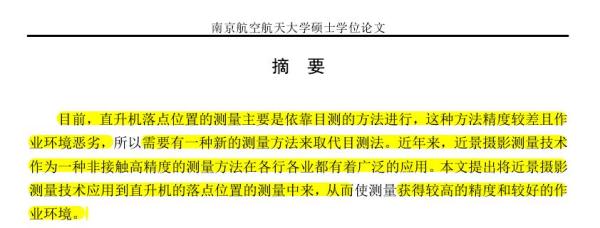
Abstract of Zhu Xiaoxiao’s thesis
Li Rui’s paper wrote: "At present, the measurement of helicopter landing position mainly depends on visual inspection, which has poor accuracy and harsh working environment, so a new measurement method is needed to replace the visual inspection method. In recent years, close-range photogrammetry technology has been widely used in all walks of life as a non-contact high-precision measurement method. "
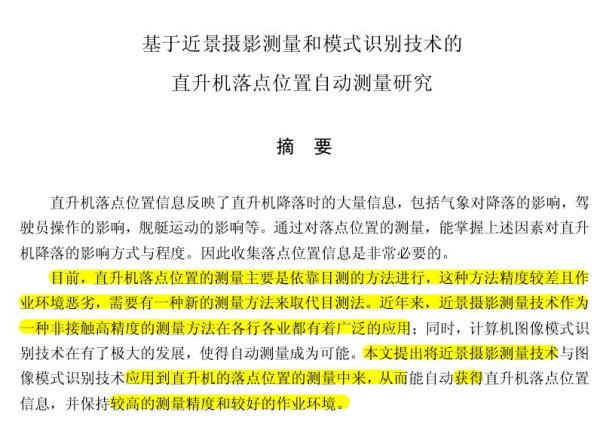
Abstract of Li Rui’s thesis
These two paragraphs are exactly the same except for a few words such as "so".
There is only one difference in the key words of the two papers. The key words of Zhu Xiaoxiao’s paper are less than those of Li Rui’s paper by "pattern recognition".
The whole chapter and paragraph of the text are not copied word for word.
Judging from the contents, the structures of the two papers are almost the same.
Zhu Xiaoxiao’s thesis is divided into five chapters, the titles of which are introduction, close-range photogrammetry theory, measurement algorithm and experimental research, construction of measurement system and field experimental research, summary and prospect.
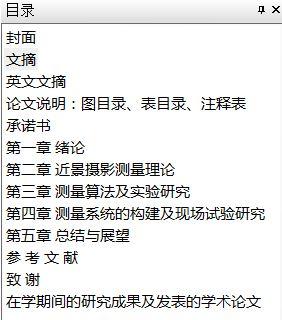
Catalogue of Zhu Xiaoxiao’s papers
Li Rui’s thesis is divided into six chapters, except the fourth chapter "Pattern recognition theory and its algorithm realization" which is not found in Zhu Xiaoxiao’s thesis. The titles of the other five chapters are the same as Zhu Xiaoxiao’s thesis, which are "Introduction", "Close-range photogrammetry theory", "Measurement algorithm and experimental research", "Construction of measurement system and field experimental research" and "Summary and prospect" in turn.
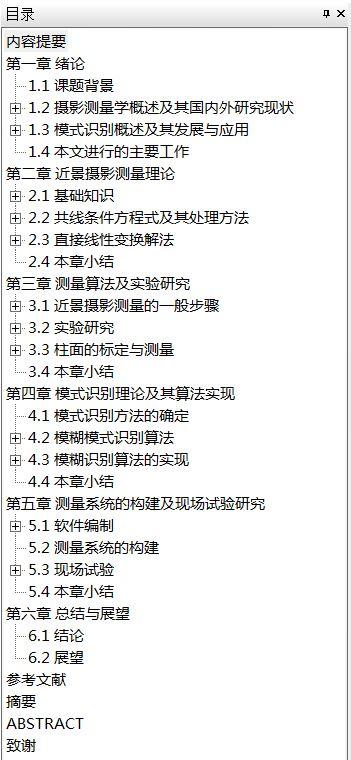
Li Rui’s thesis catalogue
The Paper reporter found that the five chapters with the same title are similar in a large area from structure to specific text expression, and several paragraphs are even verbatim.
Taking the first chapter as an example, Zhu Xiaoxiao’s paper wrote at the beginning of the section "Main research work of this paper": "In order to use close-range photogrammetry technology to collect the helicopter landing point, and achieve the purpose of high accuracy and convenient and safe measurement, the main problems studied in this paper include: the study of the basic principles of close-range photogrammetry technology (including collinear equation and direct linear transformation method); The influence of several factors on the measurement accuracy is investigated through experimental research. Compilation of measurement software system, construction of hardware system and field test research. "

The first chapter of Zhu Xiaoxiao’s thesis
Li Rui’s paper wrote: "In order to combine close-range photogrammetry technology and image pattern recognition technology to realize the automatic acquisition of helicopter landing point, and achieve the purpose of high precision, convenient measurement and safety, the main problems studied in this paper include: (1) the study of the basic principles of close-range photogrammetry technology (including collinear equation and direct linear transformation method); The influence of several factors on the measurement accuracy is investigated through experimental research. The fuzzy image pattern recognition technology is preliminarily explored. Compilation of measurement software system, construction of hardware system and field test research. "
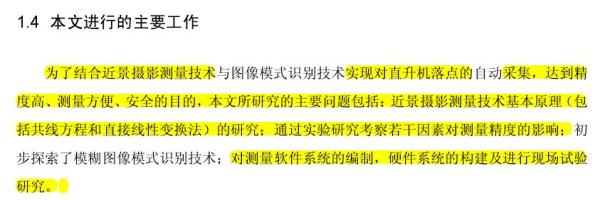
The first chapter of Li Rui’s thesis
Except for the addition of two words such as "image pattern recognition technology" and the addition of the word "automatic", these two paragraphs are almost the same, including the comments in brackets.
Taking the second chapter as an example, the two papers are highly similar from the beginning of the introduction, and discuss the basic knowledge of close-range photogrammetry theory, collinear condition equation and its processing method, direct linear transformation solution and so on in almost exactly the same language.
For example, the introduction of the second chapter of Zhu Xiaoxiao’s thesis is: "Close-range photogrammetry theory is the basic theory used in this topic. This theory establishes the mapping relationship between the measured coordinate space and the photo coordinate space, which is a function of the relative positions of the two coordinate spaces and camera parameters. Through this mapping relationship, the internal and external elements of the camera can be calibrated and the position of the object can be measured. These two applications are a pair of opposite processes. The internal and external elements of the camera are calibrated by knowing the real space coordinates and the corresponding photo space coordinates to solve the camera parameters. The measurement of object position is to know the camera parameters and photo space coordinates to solve the real space coordinates. This chapter mainly introduces the principle of close-range photogrammetry. "
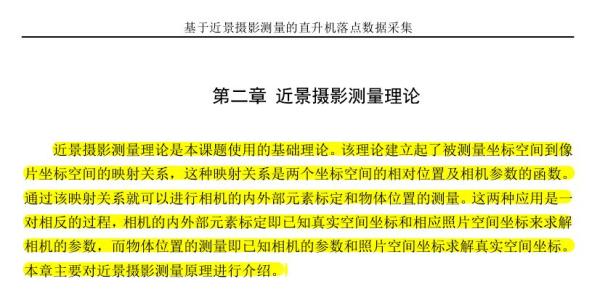
Chapter 2 of Zhu Xiaoxiao’s thesis
Li Rui’s paper wrote: "Close-range photogrammetry theory is one of the basic theories used in this topic. This theory establishes the mapping relationship between the measured coordinate space and the photo coordinate space, which is a function of the relative positions of the two coordinate spaces and camera parameters. Through this mapping relationship, the internal and external elements of the camera can be calibrated and the position of the object can be measured. These two applications are a pair of opposite processes. The internal and external elements of the camera are calibrated by knowing the real space coordinates and the corresponding photo space coordinates to solve the camera parameters. The measurement of object position is to know the camera parameters and photo space coordinates to solve the real space coordinates. This chapter mainly introduces the principle of close-range photogrammetry. "
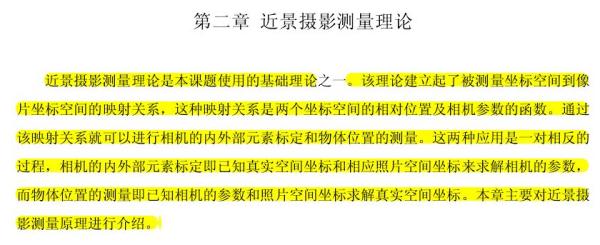
The second chapter of Li Rui’s thesis
In these two paragraphs, Li Rui’s thesis is exactly the same as Zhu Xiaoxiao’s except for the word "one".
Take the third chapter of the two papers as an example. The contents of the whole chapter are highly overlapping, and the positions of broken lines of several paragraphs are consistent.
For example, in the small-scale three-dimensional space measurement experiment, Zhu Xiaoxiao wrote in the "experimental scheme": "For three-dimensional photogrammetry, the calibration point must have three-dimensional coordinates. In the experiment, a number of rod-shaped markers with a certain height are made, as shown in Figure 3.2(a), and the dot with a diameter of 2mm at the top of the marker is used as the calibration point. In order to construct a three-dimensional object coordinate system, a network graph paper is laid flat on the ground, and an xy plane is formed with two sides of the grid paper as the X and Y axes respectively, with the direction perpendicular to the ground as the Z direction and the upper left corner of the grid paper as the origin. The three-dimensional coordinate system is shown in Figure 3.2(b). Because the minimum scale of grid paper is 1mm, the position error of calibration point in X and Y direction is 0.5 mm.. By measuring the z-direction error is 1 mm. "
Li Rui’s paper wrote: "For three-dimensional photogrammetry, the calibration point must have three-dimensional coordinates. In the experiment, several rod-shaped markers with a certain height are made, as shown in Figure 3.2(a), and the dot with a diameter of 2mm at the top of the marker is used as the calibration point. In order to construct a three-dimensional object coordinate system, a network graph paper is laid flat on the ground, and an xy plane is formed with two sides of the grid paper as the X and Y axes respectively, with the direction perpendicular to the ground as the Z direction and the upper left corner of the grid paper as the origin. The three-dimensional coordinate system is shown in Figure 3.2(b). Because the minimum scale of grid paper is 1mm, the position error of calibration point in X and Y direction is 0.5 mm.. By measuring the z-direction error is 1 mm. "
There is no difference between the above two paragraphs. Not only are the experimental schemes exactly the same, but also the measured data and errors are completely consistent.
The fourth chapter of Zhu Xiaoxiao’s thesis systematically discusses the construction of measurement system and field test research. At the end of the chapter, the "experimental conclusion" wrote: "The field test results show that the measurement of landing point data based on close-range photography technology has achieved ideal accuracy, which is greatly improved compared with the visual method. During the measurement, because only one calibration is needed, the measurement can be repeated many times, so the measurement is convenient and efficient. At the same time, the remote control method is adopted to shoot, which greatly improves the measurement environment and makes the measurement safer. Therefore, it can be concluded that it is feasible to apply close-range photogrammetry technology to helicopter landing point data collection, which can not only achieve high precision, but also make the measurement more convenient and safe. "
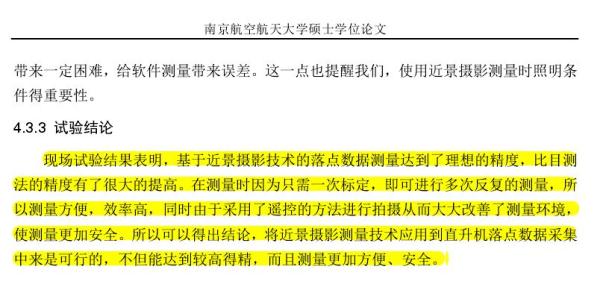
Chapter 4 of Zhu Xiaoxiao’s thesis
The fifth chapter of Li Rui’s thesis also discusses the same content. The "test conclusion" is: "The field test results show that the measurement of landing point data based on close-range photography technology has achieved ideal accuracy, which is much higher than that of visual inspection method. During the measurement, because only one calibration is needed, the measurement can be repeated many times, so the measurement is convenient and efficient. At the same time, the remote control method is adopted to shoot, which greatly improves the measurement environment and makes the measurement safer. Therefore, it can be concluded that it is feasible to apply close-range photogrammetry technology to helicopter landing point data collection, which can not only achieve high precision, but also make the measurement more convenient and safe. "
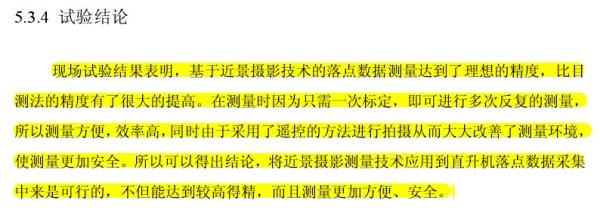
Chapter 5 of Li Rui’s thesis
The two paragraphs are verbatim.
Take the fifth chapter of Zhu Xiaoxiao’s thesis and the sixth chapter of Li Rui’s thesis as examples. The titles are "Summary and Prospect". In the "summary" part of Li Rui’s paper, except for the sentence "The application of fuzzy pattern recognition in this study has achieved good results, which has solved the problem of automatic identification of landing points and improved the automation level of this study", the other words can be found in the "summary" content of Zhu Xiaoxiao’s paper.
The "outlook" part of the two chapters is also verbatim.
In Zhu Xiaoxiao’s paper "Outlook", there are four aspects that should be broken through in the future. The first aspect is: "In theoretical research, this paper introduces the establishment and solution of collinear equation with linear error and collinear equation with nonlinear error, but for the sake of simplicity, this paper uses collinear equation with linear error. Therefore, in the future research, the collinear equation of nonlinear error should be studied, so that higher accuracy can be obtained. "
Li Rui’s paper wrote: "In theoretical research, this paper introduces the establishment and solution of collinear equation with linear error and collinear equation with nonlinear error, but for the sake of simplicity, this paper uses collinear equation with linear error. Therefore, in the future research, the collinear equation of nonlinear error should be studied, so that higher accuracy can be obtained. "
The above two paragraphs once again appear exactly the same expression.
In addition to the text, the similar parts of the two papers also include the "thank you" at the end of the article. The "thanks" in Zhu Xiaoxiao’s thesis and Li Rui’s thesis both begin with "three years of wonderful postgraduate career is coming to an end, and I will say goodbye soon …", both of which express that "I can’t help feeling deeply when I look back on various experiences in the past three years", and I want to express my sincere thanks to all those who have always cared for and supported me.
In addition, although the instructor of Zhu Xiaoxiao’s thesis is different from that of Li Rui’s thesis, both of them use the same adjectives to describe the mentor’s elder demeanor and scholar charm.
For example, Zhu Xiaoxiao wrote in his paper: "First of all, I sincerely thank my mentors Professor Wang Min and Professor Zuo Dunwen. The two tutors are noble in character, rigorous in scholarship, knowledgeable and open-minded, which embodies the demeanor of the elderly and the charm of scholars everywhere. In the process of topic selection, writing and project implementation, it is with the comprehensive and careful guidance of Professor Zuo Dunwen that the paper can be successfully completed. On the occasion of the completion of the thesis, I would like to express my heartfelt thanks and high respect to the two tutors. "
Li Rui’s thesis is: "First of all, I sincerely thank Professor Wu Tieru. The tutor is noble in character, rigorous in scholarship, knowledgeable and open-minded, which reflects the demeanor of the elderly and the charm of scholars everywhere. In the process of topic selection, writing and project implementation, it is with the comprehensive and careful guidance of Professor Wu Tieru that the paper can be successfully completed. On the occasion of the completion of the thesis, I would like to express my heartfelt thanks and high respect to the tutor. "
Except for the difference between individual words such as "loyalty" and "heartfelt" and the change of the tutor’s name, these two paragraphs are completely consistent.
It is worth noting that the two papers also thanked the same person, that is, "Teacher Yu Yaping in the laboratory".They all said that "Mr. Yu designed and manufactured the calibration objects needed for this topic, and provided a lot of guidance and help for the development of the experiment. I am especially grateful to Mr. Yu".
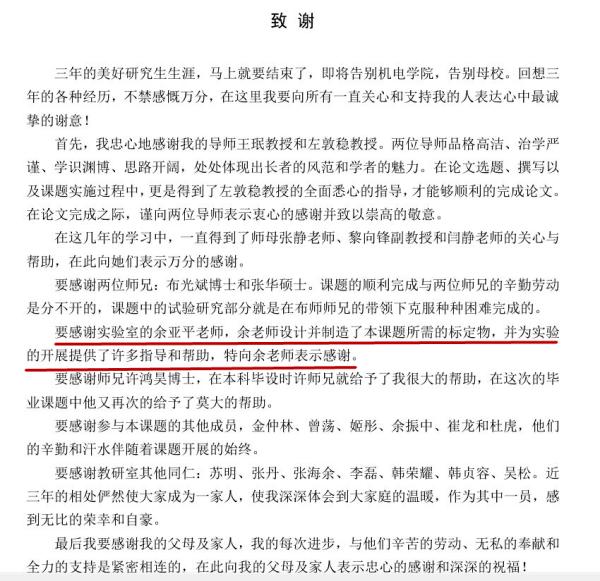
Zhu Xiaoxiao’s paper thanks
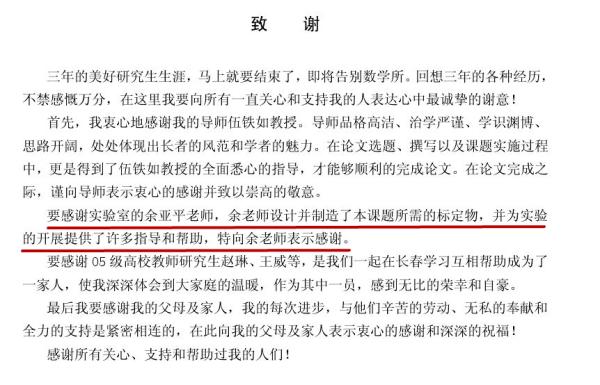
Li Rui’s paper thanks
The quotation "lost" one, and the picture and text "paid attention to one thing and lost another"
The Paper reporters also found that Li Rui’s paper made some low-level mistakes in several details due to carelessness in writing.
For example, "lost" a citation. The first citation in Zhu Xiaoxiao’s paper appeared at the beginning of the first chapter "Introduction" and was marked as "[1]". When introducing the background of the project, Zhu Xiaoxiao wrote: "This project is entrusted by the Ship System Engineering Department of China Shipbuilding Corporation to develop a computer-aided design tool for its design department. [1]”
The second and third quotes appear at the end of the first paragraph of the section "Introduction to Photogrammetry" in the Introduction. The specific content is: "Among them, photogrammetry focuses on extracting geometric information, while remote sensing focuses on extracting physical information. That is to say, the process, science and technology of obtaining reliable geometric information of the earth, its environment and other objects from a non-contact imaging system through recording, measuring, analyzing and expressing. [2][3]”
The second and third citations in Li Rui’s paper are consistent with Zhu Xiaoxiao’s paper. But The Paper reporter didn’t find the first citation in Li Rui’s paper.
This also means that the citation of Li Rui’s paper begins with "[2]".
Another place in Li Rui’s paper that "pays attention to one thing and loses the other" appears in the fifth chapter "Construction of measurement system and field test research". At the beginning of the "Error Analysis" section, it is mentioned that "As can be seen from Tables 4.2 and 4.3, the maximum average error of software measurement is 2.6cm, while the average error of visual measurement is 20.1cm…… …"
However, The Paper reporter did not find Table 4.2 and Table 4.3 in Li Rui’s paper. It is found in the context that Li Rui’s paper lists "Table 5.2 Measurement Results of Left Measuring Camera" and "Table 5.3 Measurement Results of Left Measuring Camera". The above data conclusions are also based on these two tables.
However, this is not a simple clerical error.
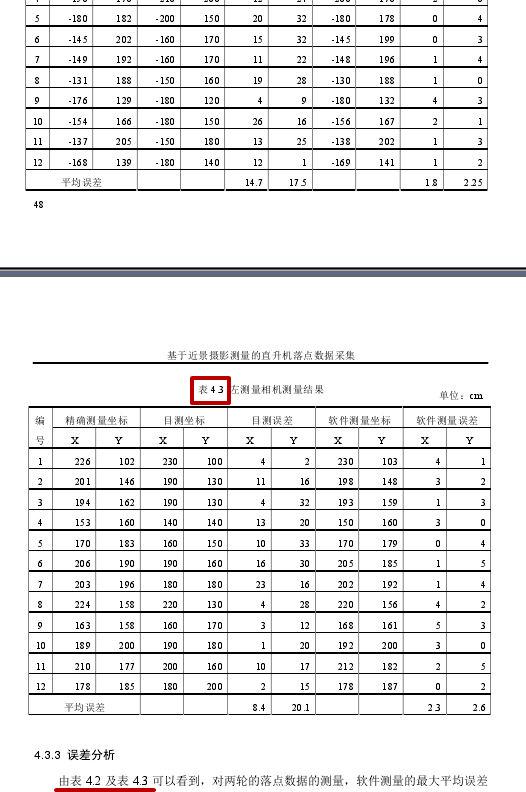
Zhu Xiaoxiao’s thesis
Li Rui’s thesis
As can be seen from Table 4.2 and Table 4.3, the maximum average error of software measurement is 2.6cm, while the average error of visual measurement is 20.1cm…… … "is exactly the same in the" Error Analysis "in Chapter 4 of Zhu Xiaoxiao’s paper. However, Zhu Xiaoxiao’s paper is consistent in picture and text, which lists "Table 4.2 Measurement Results of Left Measuring Camera" and "Table 4.3 Measurement Results of Left Measuring Camera".
Both papers have "original statements"
Although Li Rui’s thesis and Zhu Xiaoxiao’s thesis have a large area of similar words, both master’s degree theses have an Original Statement.
The original undertaking of Zhu Xiaoxiao’s thesis states: "As far as I know, the research results of this dissertation do not contain any content that others enjoy copyright, except what has been quoted in the text. Other individuals and collectives who have contributed to the research work involved in this paper have been clearly identified in this paper. "
The original statement of Li Rui’s paper is consistent with that of Zhu Xiaoxiao’s paper. And in the original statement, there is Li Rui’s own autograph and the date of April 15, 2008.
Because the completion time is one year later than Zhu Xiaoxiao’s thesis, and Zhu Xiaoxiao’s thesis has a very clear subject background, that is, "this project is entrusted by the Ship System Engineering Department of China Shipbuilding Corporation to develop a computer-aided design tool for its design department", and Li Rui’s thesis, a master student of Jilin University, completed in April 2008, is suspected of copying Zhu Xiaoxiao’s thesis.
The Paper reporter noted that,The degree category of Li Rui’s thesis is quite special, that is, "Teachers in colleges and universities are studying for master’s degrees on the job".
The Paper learned from official website of Jilin University that in November, 2015, the Graduate School of Jilin University published the Measures for Handling the Behavior of Jilin University Graduate Students in Violation of Academic Norms in its official website. Article 8 stipulates that academic degree evaluation committee shall decide whether to revoke the degree and the corresponding qualifications of those who have obtained the degree in violation of academic norms. If a decision has been made to cancel the degree and graduate qualification, the training unit where it belongs will inform its work unit of the decision and file it in its personal file, and at the same time withdraw its degree certificate and graduation certificate. Article 10 stipulates that anyone who violates academic norms has violated relevant state laws and regulations, and will be investigated for legal responsibility in accordance with relevant laws and regulations.